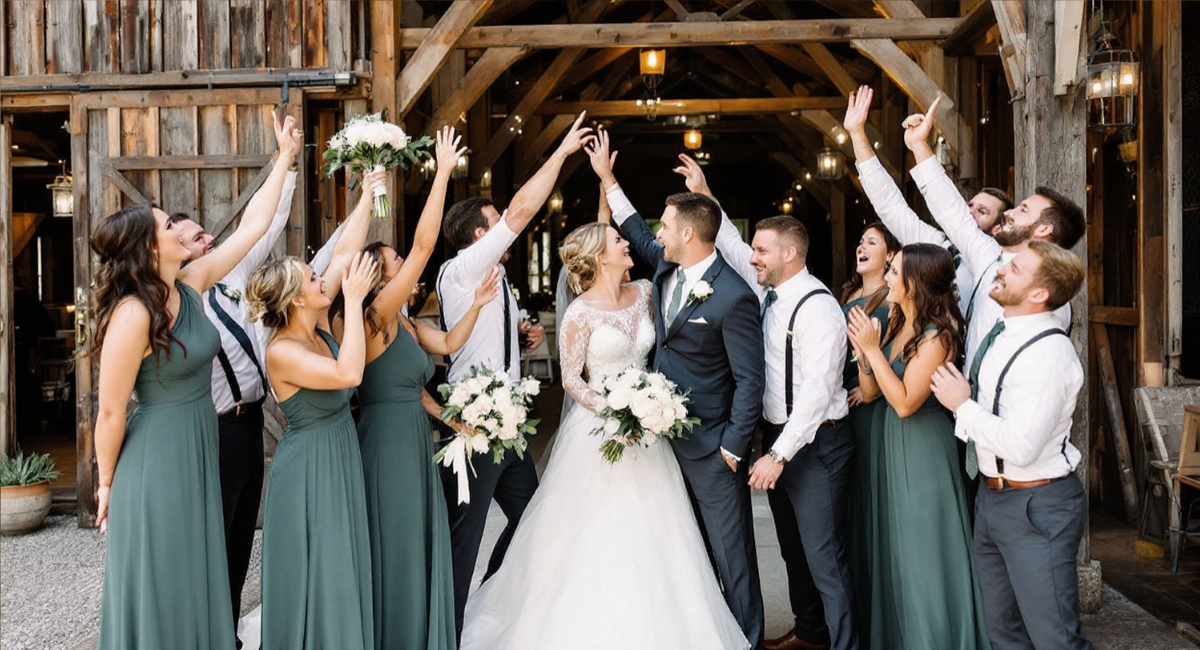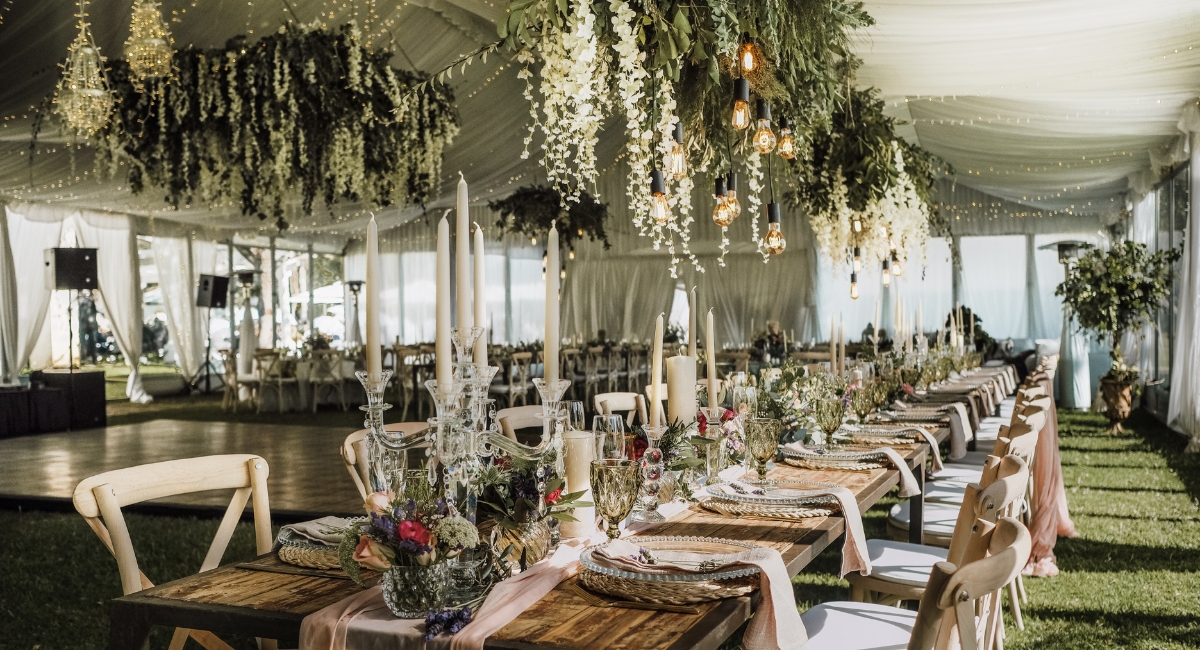Understanding the differences between a wedding ceremony vs reception is essential for planning a memorable and seamless wedding day. Each part plays a distinct role in celebrating the union of two individuals and requires different approaches for planning and execution. At Lumen Hall, we believe that knowing these differences can help couples make informed decisions and create a day that reflects their love story and personalities.
Key Differences Between Wedding Ceremony vs Reception
Although the wedding ceremony vs reception are both integral parts of a wedding day, they serve different purposes and have distinct characteristics. Recognizing these differences can help you plan each event more effectively, ensuring a seamless and enjoyable experience for you and your guests.
Formality and Atmosphere
• Ceremony: The wedding ceremony is typically formal, solemn, and structured, reflecting the gravity of the vows and commitments being made.
• Reception: The reception is more casual and celebratory, providing a fun and relaxed environment for guests to enjoy.
Duration
• Ceremony: The ceremony is usually shorter, lasting about 20-30 minutes.
• Reception: The reception is longer, often spanning 4-7 hours, depending on the time of day and venue arrangements.
Cost
• Ceremony: Generally less expensive, as it involves fewer logistical elements like catering and entertainment.
• Reception: Higher costs due to the inclusion of food, drinks, entertainment, and often more elaborate venue setups.
Venue
• Ceremony: Often held in religious or meaningful locations, such as churches, synagogues, or picturesque outdoor settings.
• Reception: Venues can vary widely, from banquet halls and hotels to gardens and country clubs. Lumen Hall, with its elegant and versatile spaces, is an ideal choice for both ceremonies and receptions, offering a seamless transition between the two parts of your wedding day. The Lumen Building Chapel is perfect for hosting a wedding ceremony while our versatile reception hall transforms to suit your desires – whether you envision a grand gala or an intimate dinner.
What is a Wedding Ceremony?
A wedding ceremony is the formal and legal joining of two individuals in matrimony. It serves as the official start of the couple’s married life, symbolizing their commitment and love for each other. This part of the wedding is deeply rooted in tradition and holds significant emotional and symbolic meaning.
Typical Components
A traditional wedding ceremony typically includes the following components:
• Processional: The entrance of the wedding party, culminating in the bride’s entrance.
• Vows: The couple exchanges promises to each other, pledging their love and commitment.
• Exchange of Rings: The couple exchanges rings as a symbol of their unending love and fidelity.
• Pronouncement: The officiant declares the couple legally married.
• Recessional: The newlyweds exit the ceremony, followed by the wedding party.
Historical Context
Wedding ceremonies have evolved significantly over time. Historically, they were deeply tied to religious and cultural traditions, often performed in churches or sacred spaces. Today, ceremonies can be customized to reflect the couple’s personal beliefs and preferences, ranging from traditional religious rites to modern, secular celebrations.
Emotional Significance
The wedding ceremony is a profound moment in the couple’s journey. It is a public declaration of their commitment and the foundation upon which their marriage is built. This part of the wedding often elicits strong emotions from the couple and their guests, as it marks the beginning of a new chapter in their lives together.
What is a Wedding Reception?
A wedding reception is the celebration that follows the ceremony, providing an opportunity for socializing and entertainment. It allows the newly married couple to “receive” their family and friends, sharing in the joy of their union. The reception is a time for merriment, featuring food, drinks, music, and dancing.
Typical Components
A wedding reception generally includes:
• Introduction of the Couple: The newlyweds are formally introduced to the guests.
• First Dance: The couple shares their first dance as husband and wife.
• Toasts and Speeches: Family members and friends give speeches and raise toasts to the couple.
• Dinner and Dessert: A meal is served, often followed by a cake-cutting ceremony.
• Dancing and Entertainment: Guests enjoy music, dancing, and other forms of entertainment.
Historical Context
Wedding receptions have their origins in the celebratory meals hosted by the bride’s parents following the ceremony. Over time, these gatherings evolved into elaborate events, often held in banquet halls or other grand venues. The reception has become a central part of the wedding day, emphasizing celebration and enjoyment.
Emotional Significance
The wedding reception is a joyful occasion, allowing the couple to celebrate their union with loved ones. It provides a relaxed and festive atmosphere where guests can share in the couple’s happiness and create lasting memories. The reception also signifies the start of the couple’s life together, surrounded by the support and well-wishes of family and friends.
Cultural Variations in Ceremonies and Receptions
Wedding traditions vary widely across cultures, each bringing its own unique customs and rituals to both the ceremony and reception. Understanding these cultural variations can inspire you to incorporate meaningful elements into your own wedding, making it a richer and more personalized celebration.
Western Traditions
In Western cultures, wedding ceremonies are typically held in churches or outdoor venues and follow a structured format with vows, ring exchanges, and a pronouncement. The reception features a formal meal, speeches, and dancing, often lasting late into the night.
Eastern Traditions
Eastern weddings often include intricate ceremonies that can span multiple days, with rituals deeply rooted in cultural traditions. The reception may also be a grand affair, featuring traditional music, dances, and elaborate feasts.
Fusion Weddings
Fusion weddings blend traditions from different cultures, creating a unique and personalized celebration. Couples may incorporate elements from both their backgrounds in the ceremony and reception, making their wedding day a rich tapestry of cultural significance.
Creating a Seamless Celebration at Lumen Hall
Understanding the differences between a wedding ceremony vs reception is crucial for planning a cohesive and memorable wedding day. Each part serves its unique purpose and brings its own set of traditions, emotions, and logistical considerations.
Let the event planners at Lumen Hall handle the details while you savor each moment. From venue decoration to coordinating with local food vendors, our comprehensive, coordinated wedding package ensures a seamless, stress-free experience.we are committed to helping you create a seamless and beautiful celebration, providing the perfect setting for both your ceremony and reception.
With our expertise and versatile venue, we ensure that every aspect of your wedding reflects your love story and exceeds your expectations. Embrace the journey of planning your wedding with confidence, knowing that Lumen Hall is here to support you every step of the way.








